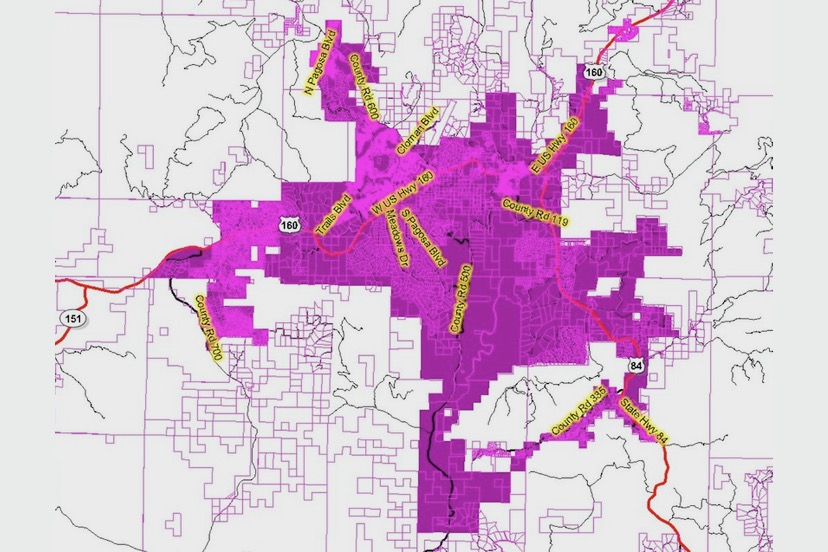IMAGE: The Archuleta County properties that pay taxes to the San Juan Water Conservancy District (SJWCD) are marked in pink.
Heard the singers playing, how we cheered for more
The crowd had rushed together, trying to keep warm
Still the rain kept pouring, falling on my ears
And I wonder, still I wonder
Who’ll stop the rain?
— from ‘Who’ll Stop the Rain’ by John Fogerty, 1970
As we prepared to start our PAWSD Board meeting on June 22, Board President Jim Smith turned to me and unfolded a page he’d taken from the weekly Pagosa Springs SUN that morning. He had marked a number of paragraphs with a highlighter marker.
“You got mentioned in the newspaper,” he smiled.
The article, by reporter Josh Pike, had covered three recent government meetings: the Monday, June 19 meeting of the San Juan Water Conservancy District (SJWCD) Board (where I’d shared the map I included in Parts Three and Four of this article series) and two meetings of the Archuleta Board of County Commissioners on Tuesday, June 20. At the second BOCC meeting, I once again shared the SJWCD map, and my belief that PAWSD will be essentially tripling the amount of water available to its customers within the next couple of years.
I thought this information might be useful to both governments. And to the general public. Since many people are concerned about water.
Apparently, the SUN thought so as well.
Disclosure: I currently serve on the Pagosa Area Water and Sanitation District (PAWSD) board of directors, but this editorial reflects only my own personal opinions, and not necessarily those the PAWSD board as a whole.
SJWCD has been studying the possibility of building an 11,000 AF (acre-foot) in the Dry Gulch valley on property jointly purchased by PAWSD and SJWCD in 2008, for just such a reservoir. PAWSD has since taken a back seat to the planning for that particular reservoir, but has a $10 million loan obligation to pay.
In my educated opinion, an 11,000 AF foot reservoir at Dry Gulch might meet someone’s needs or desires, but I’ve not seen compelling evidence that PAWSD itself will need that amount of water storage until our population surpasses 50,000 people. (And maybe, not even then.)
Over the past 20 years, the county population has grown from 10,000 to 14,000. At that rate, it will be 180 years before we reach 50,000 people.
A recent report by Wilson Water Group, commissioned by SJWCD, pointed out that the local agricultural industry has been on the decline, and there’s no evidence that an 11,000 AF reservoir would help meet its needs.
The most pressing need in the community — according to the Wilson Water Group report — is more water for fishing, rafting, and inner tubing. Exactly how a future reservoir could address that need was not entirely clear.
During my brief (three-minute) presentation to the SJWCD Board on June 19, I suggested that PAWSD customers have been solely responsible for paying off a $10 million loan obligation since 2015, while SJWCD has paid nothing. If the SJWCD Board wants to built a reservoir on the Running Iron Ranch that does not directly address the needs of our PAWSD customers — that is, a reservoir that addresses someone else’s needs — then SJWCD ought to make sure that PAWSD gets reimbursed for that $10 million loan.
To pay back our customers.
I was speaking only for myself, and not for the PAWSD Board as a whole.
One of the SJWCD Board members, Chuck Riehm, apparently wanted to discuss that question in more depth, but Board President Al Pfister cut off the conversation.
The next item on the SJWCD agenda was a proposal to hire a Durango-based engineer named Rick Ehat, to help SJWCD plan an 11,000 AF reservoir at Dry Gulch. The dollar amount $30,000 was mentioned in connection with Mr. Ehat’s proposed contract.
Speaking of money spent by governments, many of us have been following the sizable (60%?) increase in property taxes that will be owed next year by local property owners. As discussed in previous Daily Post editorials, only certain government districts will actually see greatly increased revenue as a result of those tax increases. The Archuleta County government will not see a windfall, because its revenue is controlled by the TABOR amendment. The Archuleta School District will not benefit, because they will simply end up getting less help from the state government. PAWSD is also under TABOR.
One of the districts that could see a windfall is SJWCD, which was “de-TABORed” by the voters in 2004. If taxes increase by 60%, SJWCD could see its revenues increase by 60%.
I use the word “could” because the SJWCD Board has the option of reducing their mill levy, to keep their revenue stream consistent, and thus, not taking the full 60% increase from local taxpayers.
Not that it’s a terribly significant issue. Most homeowners currently pay less than $20 a year in property taxes to SJWCD. So maybe you will pay $30 next year?
Some might ask what they will get for that $30. As a former SJWCD Board member, I would humbly suggest that you will get very little.
Maybe a reservoir that you don’t need?

